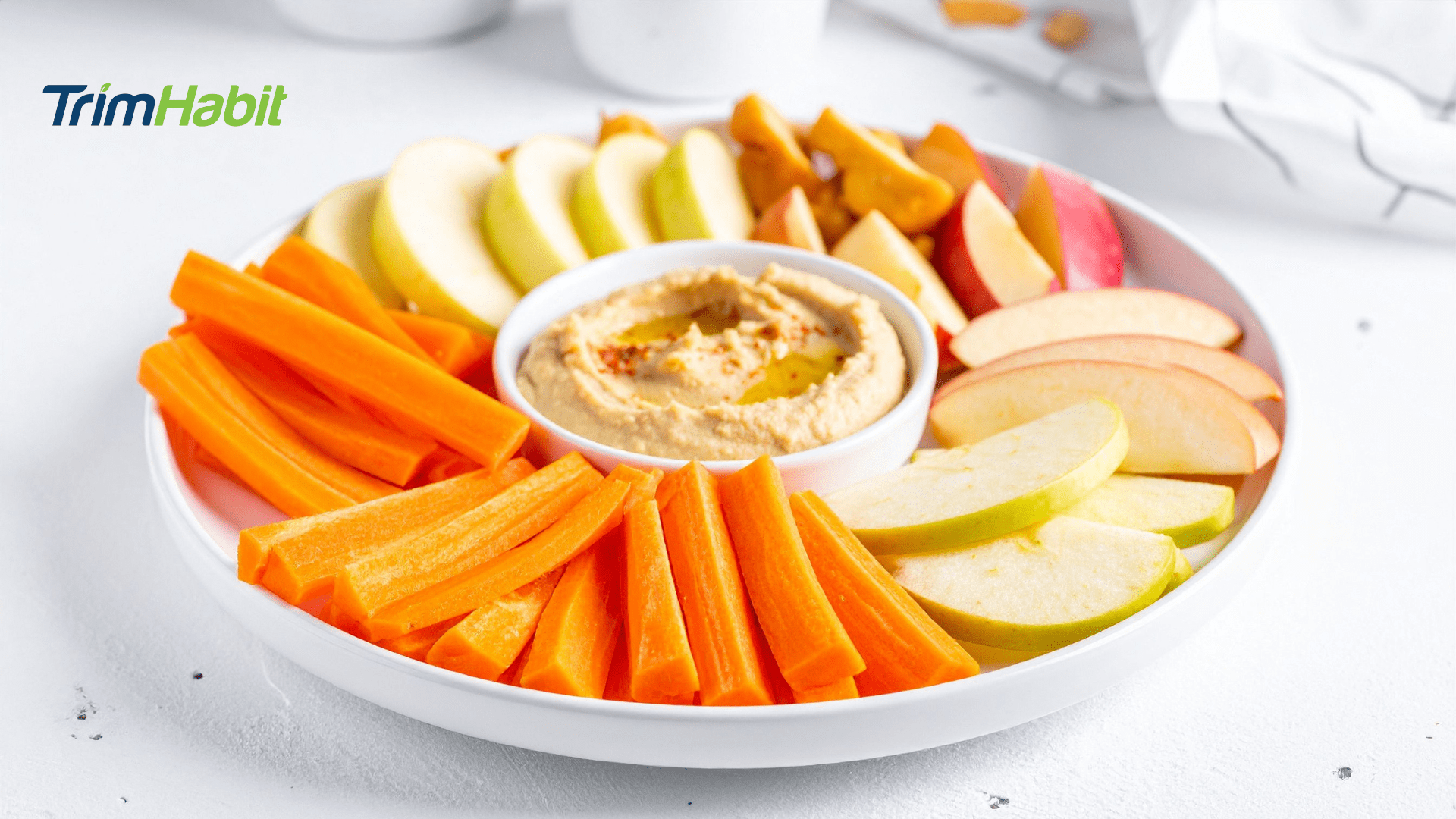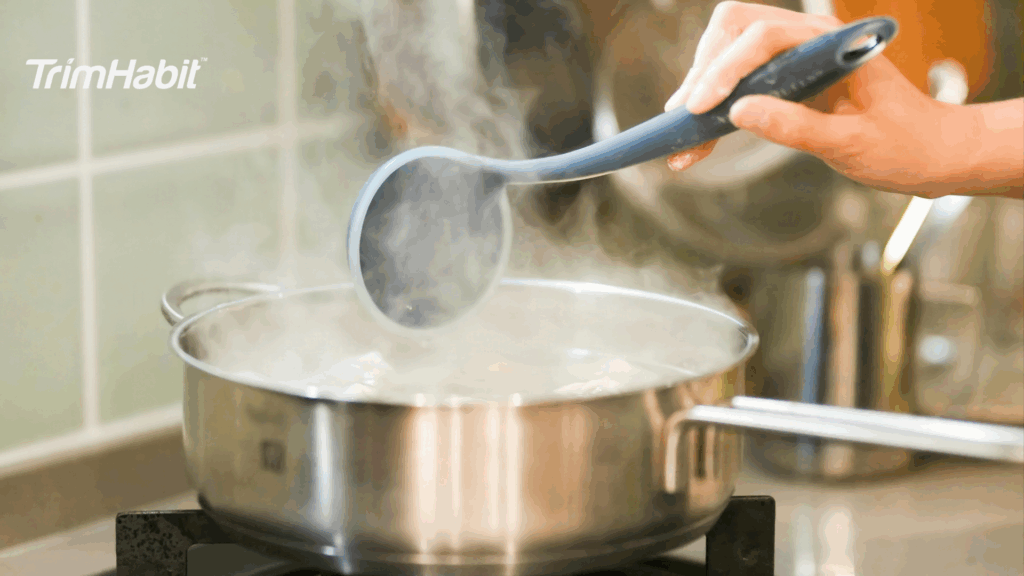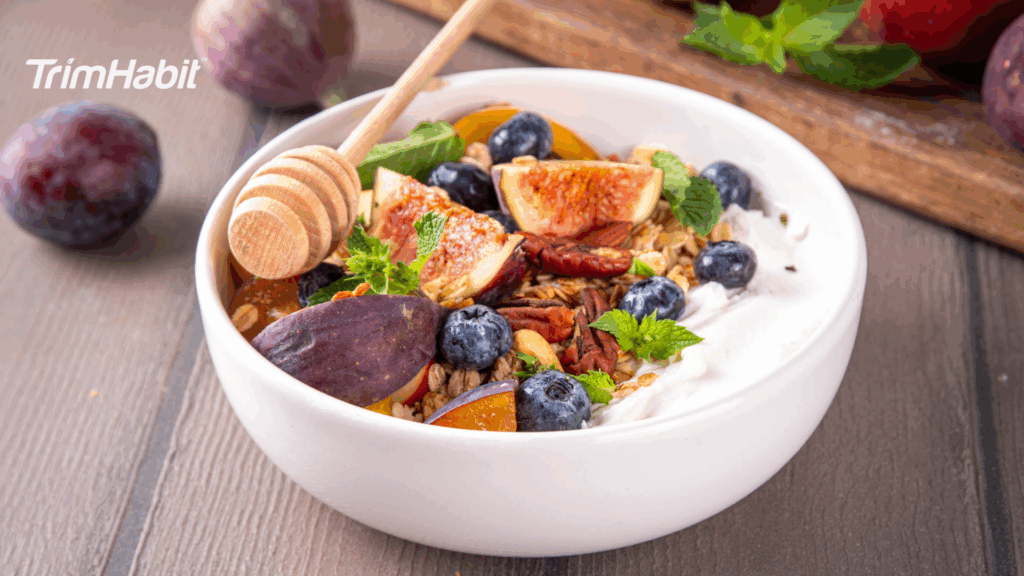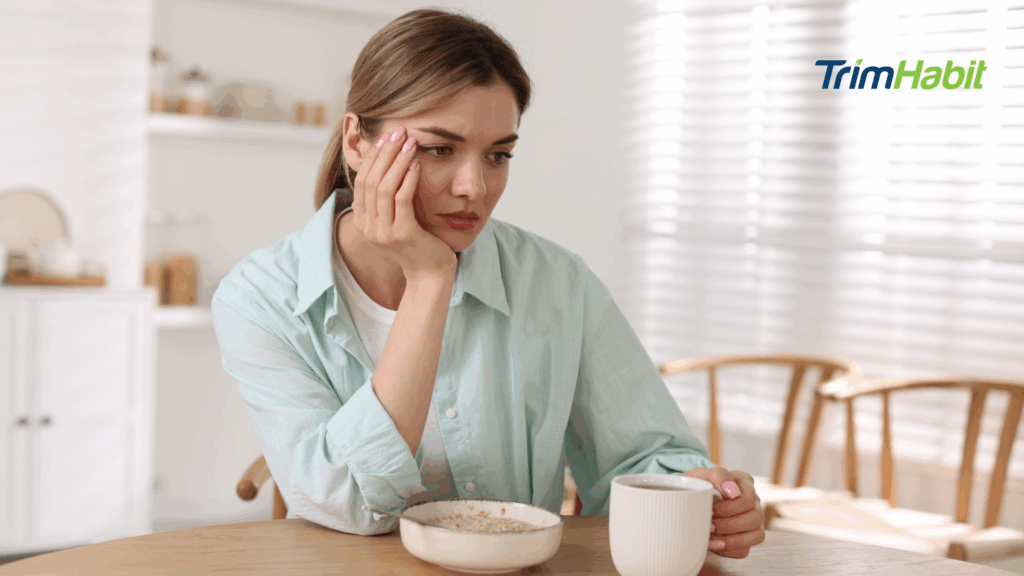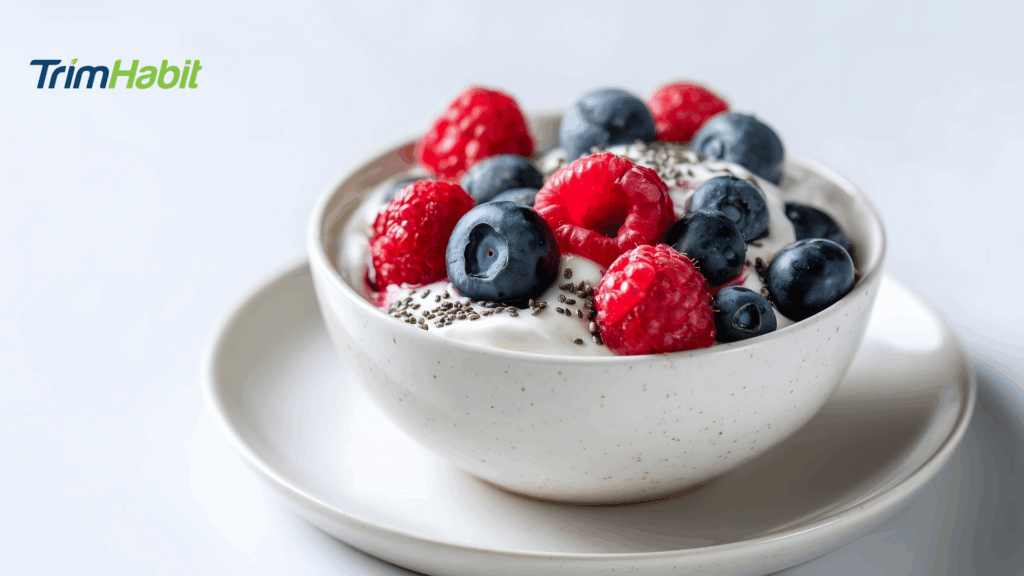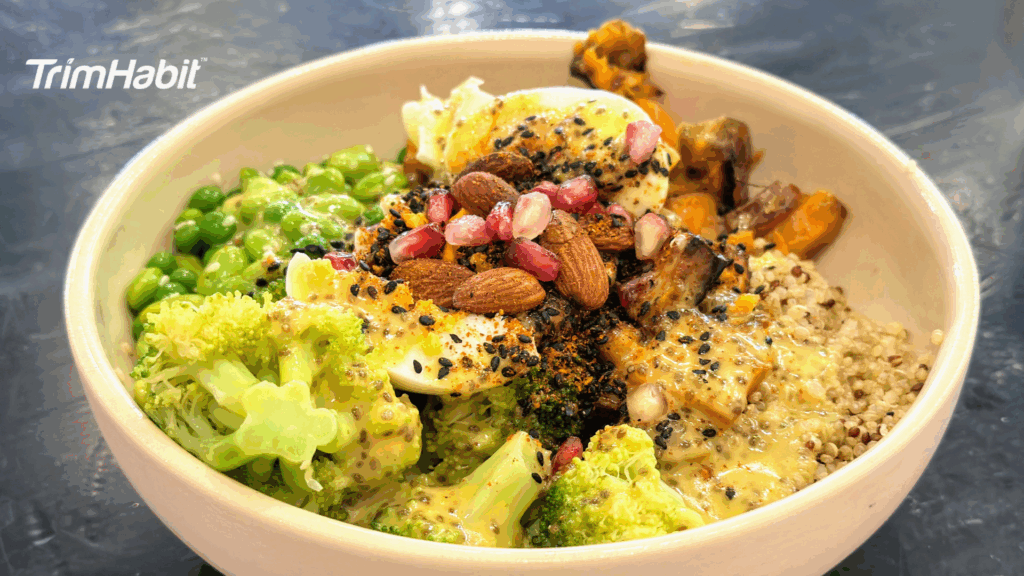When you feel queasy, it can be hard to figure out what your body can handle. Skipping food might seem easier, but it often leaves you feeling weak or dizzy.
This guide on low glycemic snacks that wont spike nausea helps you find foods that settle your stomach while keeping your blood sugar steady and your energy up.
Why Choose Low-Glycemic Snacks When Nauseous
When you’re feeling nauseous, the last thing you want is a snack that makes it worse. Choosing the right food, especially one that keeps your blood sugar steady, can help ease discomfort instead of adding to it. That’s where low-glycemic snacks come in, offering relief and gentle fuel when your stomach feels unsettled1.
Low-glycemic foods are digested slowly, leading to a gradual release of glucose into the bloodstream. This helps maintain stable blood glucose levels and prevents sharp spikes or crashes in blood sugar, both of which can worsen nausea, particularly for people with conditions like diabetes, pregnancy-related nausea, migraines, or gastrointestinal disorders. Blood sugar control is significant for people with diabetes, as poor regulation can increase the risk of high blood sugar and related complications2.
Key Criteria For A Nausea-Friendly, Low-Glycemic Snack
Not all low-glycemic foods are nausea-friendly and not all nausea-friendly foods are good for blood sugar. When trying to manage both, it helps to look for snacks that check a few specific boxes. Choosing snacks made from whole foods is especially beneficial, as they provide more nutrients and support overall health.
Here’s what to keep in mind when choosing a snack that’s gentle on the stomach and keeps your blood sugar stable:
- Minimal ingredients: Simple, minimally processed foods are less likely to trigger nausea. Whole foods are also easier to digest and provide more nutrients than processed foods3.
- Low to moderate glycemic index (GI): Foods with a low or moderate GI help prevent blood sugar spikes. High fiber foods, especially those rich in soluble fiber, support slow digestion, which helps maintain steady blood sugar levels4.
- Balanced macronutrients: Combining carbohydrates with protein sources and healthy fats is essential to a balanced meal. This combination slows the absorption of sugar and helps keep you full longer5.
Simple Snack Guidelines For Calming Nausea
1. Low to Moderate Glycemic Index (GI ≤ 55)
Look for foods that won’t cause a rapid spike in blood sugar. This means avoiding refined carbs and sugary snacks and choosing whole grains, legumes, and fruits that digest slowly. High fiber foods, especially those rich in soluble fiber, promote slow digestion, which helps stabilize blood sugar levels and supports overall health.
2. Mild in Flavor and Aroma
Strong smells or spices can trigger or worsen nausea. Choose bland, neutral-tasting snacks like plain toast, soft fruits, or lightly seasoned items. Cold or room-temperature foods often go down easier than hot ones.
3. Easy to Digest
Avoid heavy, greasy, or fibrous foods when you’re nauseous. Gentle textures like soft oatmeal, rice, or banana are less likely to upset your stomach.
4. Balanced Macronutrients
A small amount of protein or healthy fat (like from nuts or yogurt) alongside a complex carbohydrate can help stabilize blood sugar without overwhelming your system. Including various protein sources and healthy fats as an essential part of each meal is important for maintaining blood sugar stability and supporting your health.
5. Low in Fat and Sugar
Excess fat slows digestion, which can make nausea worse. High sugar content, especially from refined sources, can cause quick blood sugar swings. Limiting sugars and added sugars is important to help prevent weight gain and avoid blood sugar spikes. Keep it light and simple.
6. Minimal Ingredients
Fewer ingredients mean fewer chances of triggering nausea. Stick to simple, recognizable foods and choose options that naturally support digestion and steady blood sugar. It also helps when they’re prepared with little to no seasoning, keeping each bite gentle and easy to tolerate.
7. Small Portions
Even if a snack is technically “nausea-safe,” overeating at once can overwhelm your stomach. Keep snacks small and eat slowly. You can always go back for more if you tolerate it well.
Choosing snacks with these qualities helps your body recover, stay nourished, and avoid making nausea worse while keeping your blood sugar steady.
List Of Low Glycemic Snacks That Wont Spike Nausea
1. Simple Carbs with a Twist
These provide easy-to-digest energy with a low GI rating, especially when paired with healthy fat or protein. Not all carbs are created equal and choosing high-fiber foods like oats can help stabilize blood sugar6.
- Steel cut oats with a spoon of mashed banana or grated apple (steel cut oats are less processed and digest more slowly, supporting blood sugar control)
- Plain oatmeal topped with frozen berries for extra nutrition and natural sweetness
- Whole-grain toast with almond butter or avocado
- Brown rice cakes with thin banana slices
- Unsweetened applesauce with a sprinkle of cinnamon
Why it works: Soft, bland, and warming. The fiber in these high fiber foods helps avoid blood sugar spikes, while gentle carbs ease nausea without overwhelming the stomach.
2. Protein + Carb Combos
Balanced snacks that offer blood sugar stability and light protein, without being too heavy.
- Hard-boiled egg with a few whole-grain crackers
- Plain Greek yogurt (or dairy-free alternative like soy milk or coconut milk for a dairy-free diet) with chia seeds or a drizzle of honey
- Hummus with cucumber or carrot sticks
- Cottage cheese with a few pear slices
- Silken tofu or edamame as additional protein sources for more protein
- Canned beans (rinsed to reduce salt) as a convenient, protein-rich snack option
Why it works: These keep you fuller longer and stabilize glucose, but the mild flavor and small portions are easy to digest. Including various protein sources helps you get more protein and supports blood sugar control. Dairy-free options like soy and coconut milk suit those on a dairy-free diet.
3. Gentle, Low-GI Fruits
Fresh or lightly cooked fruits are hydrating, mildly sweet, and easy to digest. Choosing fresh fruit provides more vitamins, fiber, and hydration than dried or processed options with added sugars. For convenience, frozen berries make an excellent low-GI choice. You can add them to smoothies or oatmeal for natural sweetness and a boost of anti-inflammatory benefits.
- Stewed or baked apple (with skin removed if needed)
- Half a ripe banana
- Peeled pear slices
- Melon or cantaloupe cubes (in moderation; very low GI, but high water content)
- Frozen berries (such as blueberries or raspberries; easy to use and gentle on blood sugar)
Why it works: Naturally sweet but low on the glycemic scale, stewing or baking makes them even easier to digest. Fresh fruit and frozen berries help prevent blood sugar spikes and offer more nutrients than processed alternatives.
4. Light Savory Options
For those craving something salty or warm but still nausea-friendly.
- Plain miso soup with soft tofu (try topping with a sprinkle of pumpkin seeds for added protein and healthy fats)
- Rice porridge (congee) with a pinch of ginger or a poached egg
- Boiled or steamed sweet potato cubes
- Plain scrambled egg on a slice of whole-grain toast
- Roasted vegetables (such as carrots or zucchini) with a drizzle of olive oil for a light, fiber-rich snack
- Chickpea curry (mildly spiced) served with rice or steamed vegetables for a gentle, protein-packed option
Why it works: These are soft, warm, and comforting without strong spices or high fat content.
5. On-the-Go Nausea-Safe Options
Quick, portable, and low-GI snacks for when you’re away from home or short on energy.
- Oat-based energy bites (e.g., oats, nut butter, ground flax, light honey)
- Pre-portioned trail mix (go easy on dried fruit; focus on seeds/nuts)
- Single-serve packs of canned beans or pumpkin seeds for a portable, protein-rich snack
- Whole-grain crackers with a slice of turkey or nut butter
- Low-sugar protein bar with clean ingredients (check for low GI options)
- Frozen berries added to yogurt or oatmeal for a convenient, nutritious boost
Why it works: Minimal prep, easy to carry, and balanced for blood sugar. Choose mild flavors to avoid triggering nausea.
What To Avoid (Even If the GI is Low)
Just because a food has a low glycemic index doesn’t mean it’s safe when you’re nauseous. Some low-GI foods can worsen nausea due to their texture, smell, fat content, or preparation.
It’s also important to avoid refined grains like white rice, as these foods can cause rapid spikes in blood sugar. Processed snacks often contain added sugars and other sugars, which not only impact blood glucose but can also contribute to weight gain. Over time, these choices may exacerbate medical issues related to blood sugar management.
Here are some common pitfalls to avoid even if the glycemic index looks friendly:
1. Strong Smelling or Spiced Foods
- Onions, garlic, curry, heavily seasoned dishes
Why to avoid: Strong odors are a well-known nausea trigger, especially when warm.
2. High-Fat Foods
- Cheese-heavy dishes, fried snacks, full-fat dairy, fatty meats
Why to avoid: Fat slows digestion, worsens nausea, and makes food feel “sitting” in your stomach.
Instead, choose healthy fats in moderation, such as those found in nuts, olive oil, and eggs, as these support heart health and better blood sugar regulation.
3. Artificial Sweeteners and Sugar-Free Snacks
- “Diet” protein bars, sugar-free gums, or drinks with sorbitol or aspartame
Why to avoid: These can irritate the gut and cause bloating, gas, or a queasy feeling.
4. Dense or Greasy Processed Foods
- Low-GI doesn’t mean healthy. Some processed snacks (like sausage, jerky, or low-carb chips) may technically be low-GI but are hard on a sensitive stomach. Many processed snacks are also made with refined grains, which can negatively impact blood sugar.
Why to avoid: Heaviness and poor digestibility can worsen nausea.
5. Very Fibrous or Tough Foods
- Raw broccoli, kale salads, dry whole-grain breads
Why to avoid: High fiber is great long-term, but it can be too rough when your stomach is unsettled.
6. Carbonated or Acidic Drinks
- Even sugar-free or low-GI fizzy drinks (like sparkling water or diet sodas)
Why to avoid: It can cause bloating, burping, or reflux, making nausea worse.
7. Large Portions
- Even healthy foods can overwhelm your stomach in big amounts
Why to avoid: Overeating at once can trigger nausea by stretching the stomach or slowing digestion.
Bottom line: When dealing with nausea, gentle trumps glycemic index alone. Choose foods that are not just low-GI, but also light, bland, and easy to digest.
Tips For Eating While Managing Nausea
Even the healthiest snacks can backfire if you eat them incorrectly when you’re nauseous. The key is to listen to your body and make gentle, strategic choices.
Here are some practical tips for eating while managing nausea whether it’s from illness, pregnancy, medication, or other causes:
1. Eat Small, Frequent Meals
- Large meals can overwhelm your stomach.
- Try eating small amounts every 2–3 hours to keep blood sugar stable and avoid an empty stomach (which can make nausea worse).
2. Stick to Cold or Room-Temperature Foods
- Warm or hot foods often have stronger smells, triggering nausea.
- Cold snacks like yogurt, fruit, or chilled toast are usually more tolerable.
3. Sip Fluids Between Meals, Not During
- Drinking while eating can fill up your stomach too fast.
- Sip water, electrolyte drinks, or herbal teas (like ginger or peppermint) slowly between meals to stay hydrated without adding pressure to your digestive system. Proper hydration can also help manage high blood sugar levels by supporting your body’s ability to regulate glucose.
4. Keep Snacks Simple and Bland
- Choose foods with minimal seasoning and ingredients.
- Bland carbs (like toast, rice, or oats) often go down easiest and can be paired with a small amount of protein or healthy fat.
5. Eat Slowly and Mindfully
- Rushing can increase discomfort or bloating.
- Take small bites, chew thoroughly, and stop when you feel full or uncomfortable.
6. Try Eating Before Getting Out of Bed (Morning Nausea)
- If you wake up nauseous, keep dry crackers, rice cakes, or a banana near your bed.
- Eating a little before moving can help settle your stomach, especially during pregnancy or early illness recovery.
7. Listen to Your Body’s Signals
- If a food you usually love suddenly sounds awful, skip it for now.
- Taste and tolerance often change during nausea. Focus on what feels manageable in the moment, and return to a full diet gradually.
Bonus Tip:
Keep a small “safe snack” kit nearby, whether at your desk, in your bag, or by your bed, so you’re never caught off guard when nausea strikes.
Summary
When nausea hits, skipping food can make things worse by causing your blood sugar to drop. The key is to choose low-glycemic snacks that digest slowly, keep glucose levels steady, and are gentle on your stomach. Low-GI foods help prevent sudden blood sugar swings that can intensify nausea, especially for people managing diabetes, pregnancy-related nausea, migraines, or digestive issues. Not all low-GI foods are easy on the stomach, though. The best options are bland, mild in aroma, easy to digest, low in fat and sugar, minimally processed, balanced with protein or healthy fats, and eaten in small portions.

